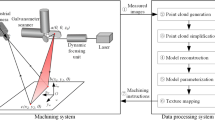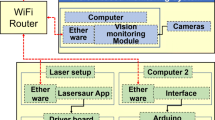Abstract
An important step in many manufacturing processes is the definition of the three-dimensional form of an object's shape. A common example is the definition of a designer's model created in clay or wood. A three-dimensional laser scanner offers the advantage of speed and non-contact sensing compared to traditional touch probe sensing. The three-dimensional data produced have been used in a multi-patch reverse engineering program in order to model objects where many types of surface patches, such as quadric and free-form, are blended together on one object. The surface reconstruction algorithms have been demonstrated to provide accurate and smooth surfaces that are suitable for CAD database integration and CNC machine toolpath generation. The algorithms have been implemented in an interactive 3D surface modelling program that produces surfaces compatible with current CAD/CAM systems. The application of the technology to the reverse engineering of a typical injection moulded part is described.
Similar content being viewed by others
References
C. Bradley and G. W. Vickers, “Automated rapid prototyping utilising laser scanning and free-form machining”,Annals of CIRP Manufacturing Technology 41(1), pp. 437–440, 1992.
C. Bradley and G. W. Vickers, “Free form surface reconstruction for machine vision rapid prototyping”, Optical Engineering, 32(9), pp. 2191–2200, September 1993 inOptical Engineering, September 1993.
M. Rioux, G. Bechthold, D. Taylor and M. Duggan, “Design of a large depth of view three-dimensional camera for robot vision”,Optical Engineering 26(12), pp. 1245–1250, December 1987.
R. M. Bolle and D. B. Cooper, “On optimally combining pieces of information, with application to estimating 3-D complex object position from range data”,IEEE Transactions on Pattern Analysis and Machine Intelligence, PAMI-8(5), pp. 619–638, September 1986.
R. L. Hardy, “Multiquadric equations of topography and other irregular surfaces”,Journal of Geophysical Research 76(8), pp. 1905–1915, March 1971.
Author information
Authors and Affiliations
Rights and permissions
About this article
Cite this article
Milroy, M.J., Weir, D.J., Bradley, C. et al. Reverse engineering employing a 3D laser scanner: A case study. Int J Adv Manuf Technol 12, 111–121 (1996). https://doi.org/10.1007/BF01178951
Issue Date:
DOI: https://doi.org/10.1007/BF01178951




